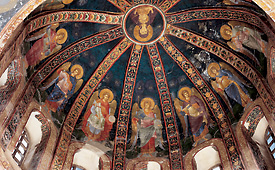“Vaults of Heaven: Visions of Byzantium,” presented at the Kelsey Museum, is an exhibition that focuses on photographs of select Byzantine churches in Turkey by the critically acclaimed photographer Ahmet Ertug.
Photos presented in the exhibit explore some of the Christian themes in Byzantine art from the sixth though the 14th centuries. Often executed on a monumental scale in both fresco and mosaics on church walls, these images served to instruct and inspire the faithful.

This image of the west bay dome, Church of Christ of Chora, Istanbul, built in the 11th –12th century and restored in 1316, is from the Kelsey Museum of Archeology exhibit “Vaults of Heaven: Visions of Byzantium.” Photo by Ahmet Ertug.
The exhibition also contains more intimate objects from the Kelsey Museum and U-M Museum of Art Byzantine and Islamic collections, including coins, pages from manuscripts, tiles, glass, ivory and bone carvings, and objects used in daily life.
Christianity had a major impact, not only on the daily lives of people within the Byzantine Empire, but on its art and architecture as well. The new religion exalted the spirit over the body, valued the idea of revelation and preparation for the afterlife, and rewarded pious behavior. These ideas were expressed artistically through a series of specific symbols and narratives.
Ertug’s photographs highlight some of the most important sacred narratives that persisted throughout the centuries in Byzantine art: the Annunciation, the Nativity, the Crucifixion, Christ’s Anastasis (the release of certain figures from hell) and the Deesis (the figure of Christ flanked by the entreating figures of the Virgin and John the Baptist).
Part I of the exhibit is presented through Jan. 23. Part II is scheduled Feb. 4-May 29.

